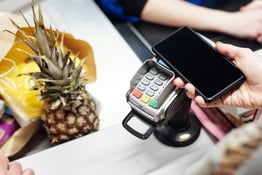With the craft beer revolution entering its fifth decade — or its 500th, depending on when you start that timer — we’ve entered a moment of incredible convergence. One of the oldest crafts on the planet has intersected with some of the newest, most tricked-out restaurant technology in hospitality. If you’re in the hospitality business, it’s an incredible time to be brewing your own beer. And if you’re brewing beer at any sort of scale at all, an abundance of softwares, hardwares, and other tech tools are at hand to ensure you stay competitive in the wider landscape of food and drink.
Most of the tech at your brewery or taproom needs to do one thing well: Get out of the way of the star attraction. Perhaps it was Buffy (she of the vampire-slaying persuasion) who said it best: “Lots and lots of beer. It’s nice. Foamy. Comforting. It’s just … beer.” Gussy it up with raspberries or apricots or coffee or cacao nibs or bananas or lactose or guava or orange peels or hemp or whatever other whatnot you like, but your beer will forever rise from four simple components: water, yeast, grain, hops. So easy! It’s as if the earth itself knew we’d need them in abundance. Whether your customers are feeling weary, merry, or both, they know they’ll find that foamy comfort at your establishment.
Opening up a brewpub or a taproom takes more than fine hops and some brew tuns. You’ll want to consider such relatively new developments as beer delivery options, and marketing in an increasingly competitive space. It also takes a mountain of energy, time, and expense. The best tech solutions will save you all three, if you select wisely. Below you’ll find some of the most important of the tools of the trade, arranged and broken down with the brewery or taproom owner in mind.
Your taproom or brewery needs a strong POS (point of sale system)
To process high sales volumes (and withstand the occasional pratfall of a tipsy patron), your POS must be durable, flexible, and lightning-fast. Square has captured the lion’s share of this market, with 38% of breweries using this well-known SaaS provider to process in-person transactions. Also popular is Arryved, built specifically for bars and taprooms. It boasts sophisticated inventory-tracking features and can simultaneously track your inventory with patrons’ open tabs. You’ll get a personalized sales dashboard, so monitoring business operations on the back end is a snap.
Both Square and Arryved offer mobile POS solutions, freeing your staff to mingle among your clientele. Arrryved users are especially gaga for its ability to pre-authorize payment cards, which allows you to start a tab without having to retain a physical card; Square falls short here.
Square and Arryved have similar pricing structures. Both offer their software free of charge, passing costs onto you via their proprietary payment gateways. Square is more transparent about its standard processing fee (2.6% + $0.10). Potential Arryved customers will have to contact the company to pin down their rates.
For those who prefer an on-premise POS solution, BrewPOS is a solid legacy system built specifically for bars and taprooms. Unlike the aforementioned systems, signing on with BrewPOS necessitates the purchase of hardware. The company peddles a variety of devices, ranging from conventional terminals to lightweight tablets. On top of the cost of the hardware, the software runs $69/month per station. On the bright side, you get to choose your own merchant services provider, with whom you’re likely to work out a deal better than the one-size-fits-all offerings provided by Square and Arryved.
Breweries have specific needs from business management softwares
Running a brewery is a complex operation, so you’ll want some best-of-breed software to help you manage your business. Don’t get mired in a quicksand of spreadsheets or (heaven forbid!) a clipboard and pen. Big names in the brewery management software business include Ekos, Orchestra Cloud, Brewd, and Vicinity Brew.
Investing in all-in-one management SaaS saves the prudent brewer countless hours on purchasing, beer formula management, quality control and TTB report generation. For complete control over every aspect of your business, opt for software that integrates with your POS (like Ekos or Orchestra Cloud) and your accounting software.
Breweries are in the eCommerce business now
We’ve moved into an era of widespread compulsive food delivery, and as the undisputed breakfast of champions, beer also deserves to be delivered. If you retail, consider partnering with Drizly, North America’s largest and longest-running alcohol delivery app. There are no sign-up, maintenance, or cancellation fees, and, like all order and delivery marketplaces of its kind, Drizly can act as a marketing arm for your business. Similar to other B2C companies (think DoorDash and GrubHub), Drizly’s pricing structure isn’t exactly what you’d call transparent. Drizly takes a cut of all sales, and, per its website, its model “reflects the fact that we operate in a highly regulated market,” and is “built to be compliant with regulatory bodies in every state.” Translation: You’ll have to talk to a rep who can give you a quote based at least in part on your local laws.
Another platform to look at is Bevv, designed specifically for craft breweries. You can sell through Bevv’s marketplace and through your own custom site. Bevv specializes in end-to-end logistics, ensuring that you remain compliant at every step from label generation to delivery. Bevv also takes a healthy sip of each sale (10% to 15%) on top of monthly fees, so you’ll want to crunch the numbers before you get involved.
For a totally different model, scope out Bottlecapps, which supplies booze retailers with store-branded apps (complete with targeted push notifications for maximum CRM efficiency) for a monthly price — no transaction fees to speak of. On your branded app, customers can browse inventory, peruse tasting notes, find out about special events at your brewery, earn and redeem rewards points, and, of course, buy your beer, for pick-up (including curbside) as well as delivery. Bottlecapps also lets you sell through BottleRover, its proprietary online marketplace (sensing a theme here?).
Another rising software with a similar approach (marketplace distribution + option to build out a bespoke ecommerce site) is TapRm. Its website states that it’s “currently looking for new brand partners, especially those that do not already have a distributor and have a mindset and passion for e-commerce, digital marketing, and consumer growth.” Always be building that customer base.
How beer brewers launch clubs and subscriptions
There’s more to craft beer ecommerce than simply packaging and shipping individual orders at the whims of thirsty strangers. Restaurant wine clubs are the rage right now in part because they leverage two essential elements: restaurants’ expertise, and their customers’ existing loyalty. If anything, beer plays to these strengths even more directly. Smaller breweries in particular have a culture of devoteeism, and the reflective retailer will want to capitalize on the cultish human instinct toward communitas around a common object of veneration (in this case, your signature Saison).
You can foster connection with your customers while securing a regular profit by offering subscription services, clubs, and allocations. Designed for wineries and high-end breweries looking to stabilize their business through the power of recurring revenue, Vinespring provides solutions to help you maximize on the recent astronomical growth of the subscription economy. Vinespring integrates with inventory management software like Ekos so you can enjoy the predictability afforded by subscription models. Vinespring’s tools are customized, so you can offer tiered club memberships with perks like access to educational videos and other unique content. Whatever club software you choose, you’ll want access to club-specific reporting so you can keep track member status, cancellations, and geographic data.
Taproom self-pour technologies are getting better
Nothing makes a patron thirstier than watching a perfect pour. Like everything else, technology has revolutionized the traditional tap system, both for staff and for patrons turned loose with a pint glass. Self-pour companies like iPourit and PourMyBeer are established enough now that they’ve worked out their old kinks. As more owner-operators discover the labor-saving and sales-boosting benefits of the self-pour way of life, breweries are adopting these systems more widely.
“With these kinds of self-serve systems, breweries use pre-authorized cards like you might find at an arcade,” says Luisa Castellanos, co-founder of the restaurant tech consulting firm Science on Call. “You pre-authorize an access card that’s tied to a customer’s credit card, and at the end of the night the customer hands it back and you capture the amount they’ve spent. Or you can load the card to have a two-drink maximum before the customer has to come back and put more money on it. That way, you keep track of sales while making sure patrons don’t over-serve themselves.”
How to think about social media, events, and music for your taproom
Most young people remain firmly embedded in the social media matrix that owns us all, and the particularly youthful brewery-going crowd is no exception. Breweries are visually interesting and cheerfully hands-on sort of spaces, so lean into your social media strategy. The same best practices for restaurant social media apply to your taproom: your posts searchable with hashtags, geotag your events, and engage, engage, engage! Post tap lists ahead of time, generate visibility with contests and giveaways, and don’t skimp on the time it takes to stage and snap that perfect pic of your latest golden-brown triumph.
If you’re running a brewery, chances are you’ve given as much thought to your ambiance as you have to your signature stout. Milk this for all its worth by turning your brewery into a killer event space. A platform like Tripleseat can help you streamline event management tasks such as booking, floor plans, and table assignment. It also pays to list with EventUp, Tripleseat’s online venue directory. EventUp takes no commission on bookings and offers tiered pricing packages that enlist various levels of SEO horsepower. The Cvent Supplier Network is another must-list venue network that enables you to share your need-to-know stats (capacity, catering parameters, parking details) with seekers. Cvent uses a freemium model for venues, meaning that it costs nothing to join its Network but you can pay more for greater exposure to planners.
There’s a ton more to consider if you’re hosting a public or private event, but one thing to keep in mind is to update your social media channels as well as your Google Business profile in the event of, well, a private event, if it’s going to affect your hours and availability.
Also, hey, you need some tunes. Technically speaking, it’s unlawful to blast your workaday Spotify account in your business establishment, so check out something like Soundtrack Your Brand to get bops licensed for brewery-streaming. It’ll run you between $35 and $50 a month, depending upon your pricing tier, and for many, it’s worth it. SYB’s statistics find that 85% of your potential patrons think it’s important for a pub to play music they like, and a whopping 96% notice the music. The oblivious 11% presumably have made one too many trips to the self-serve taps.





